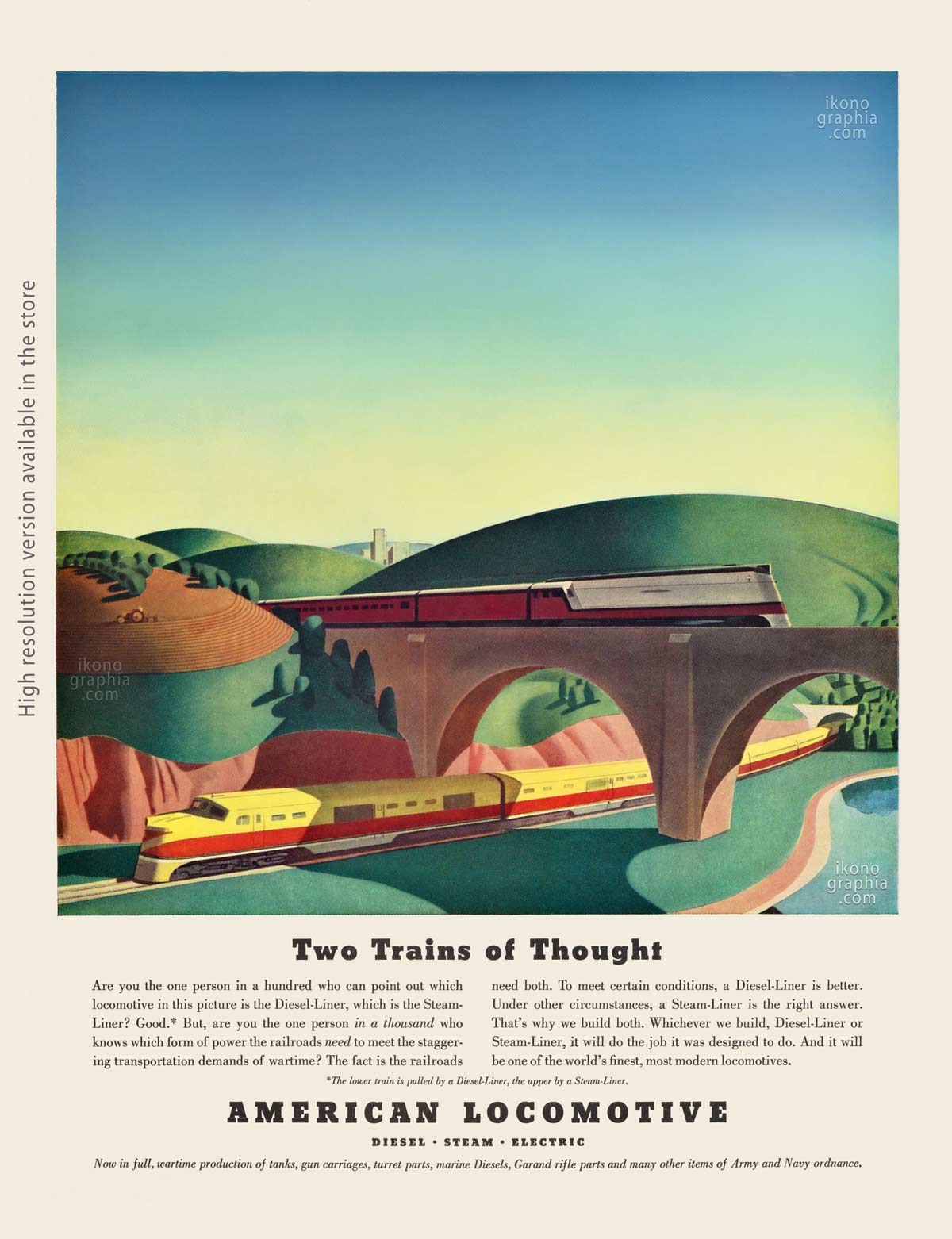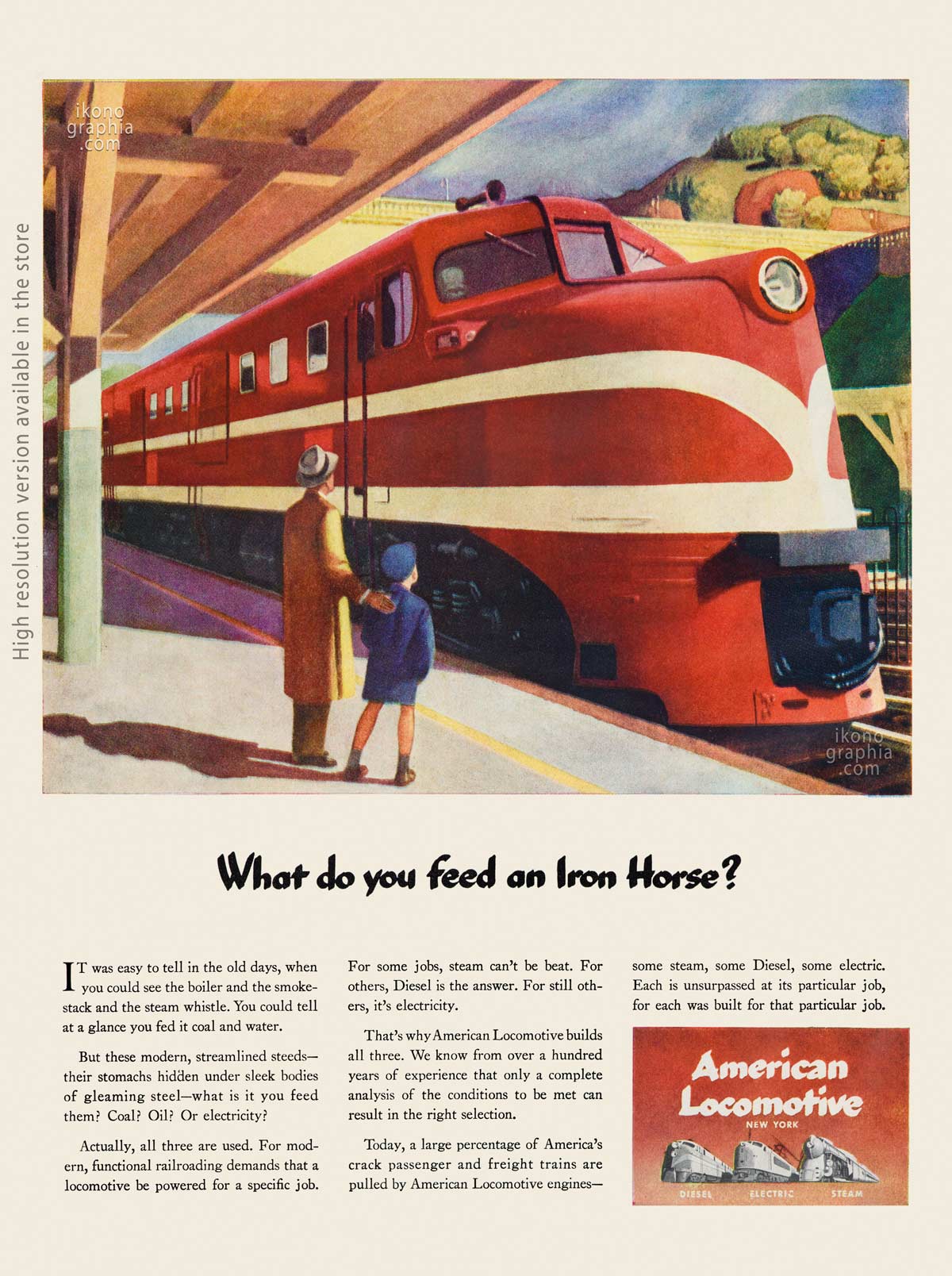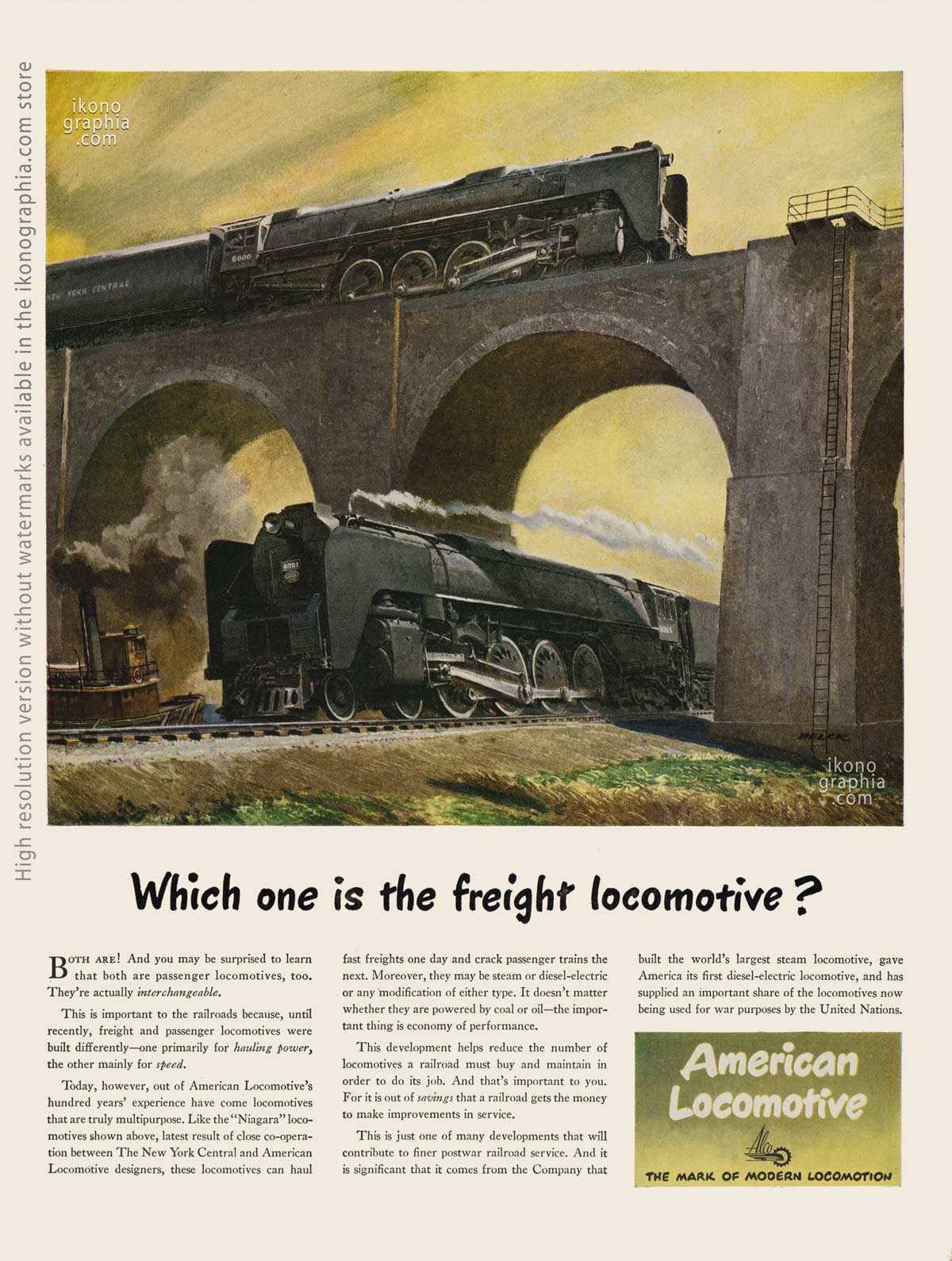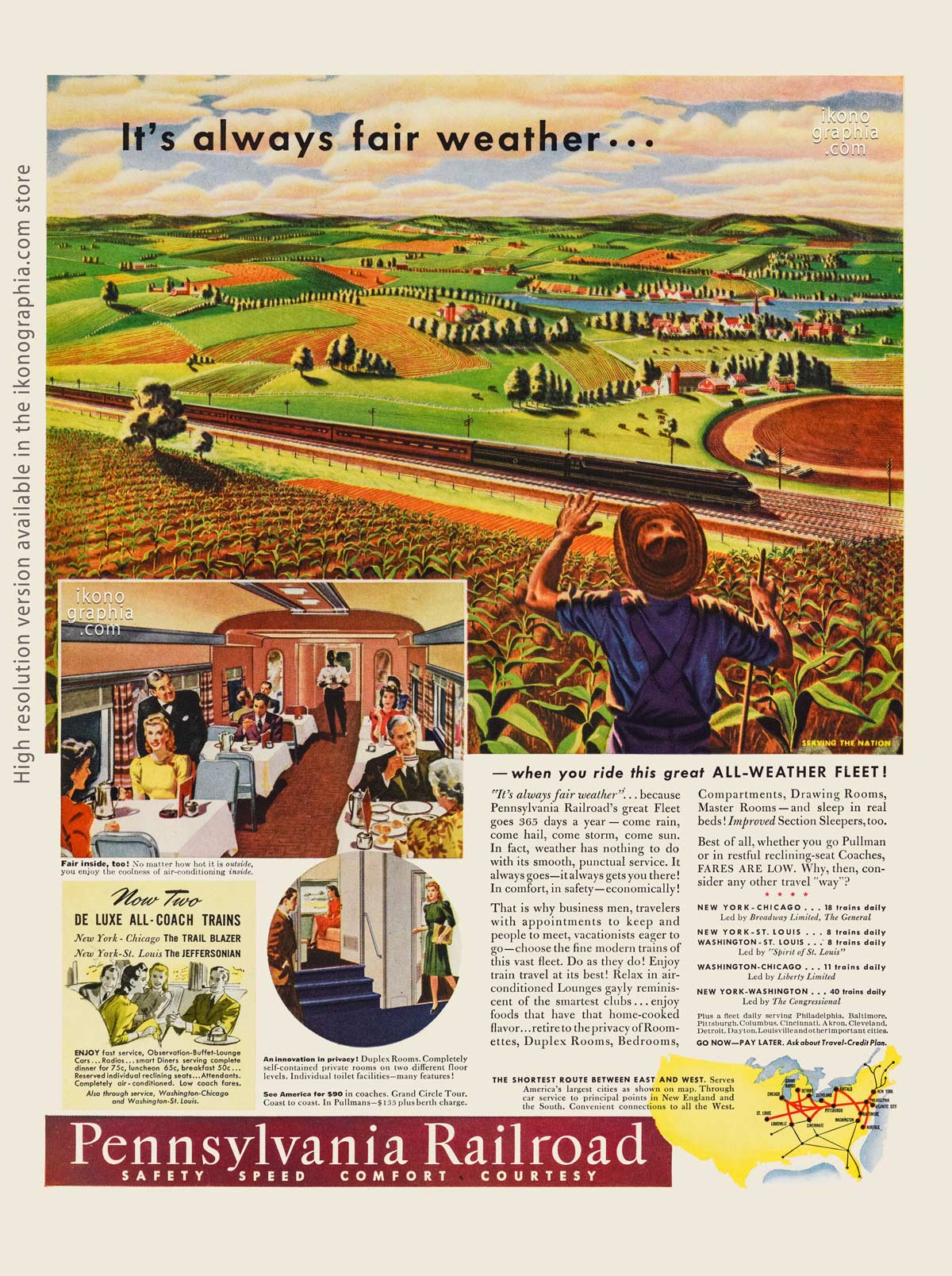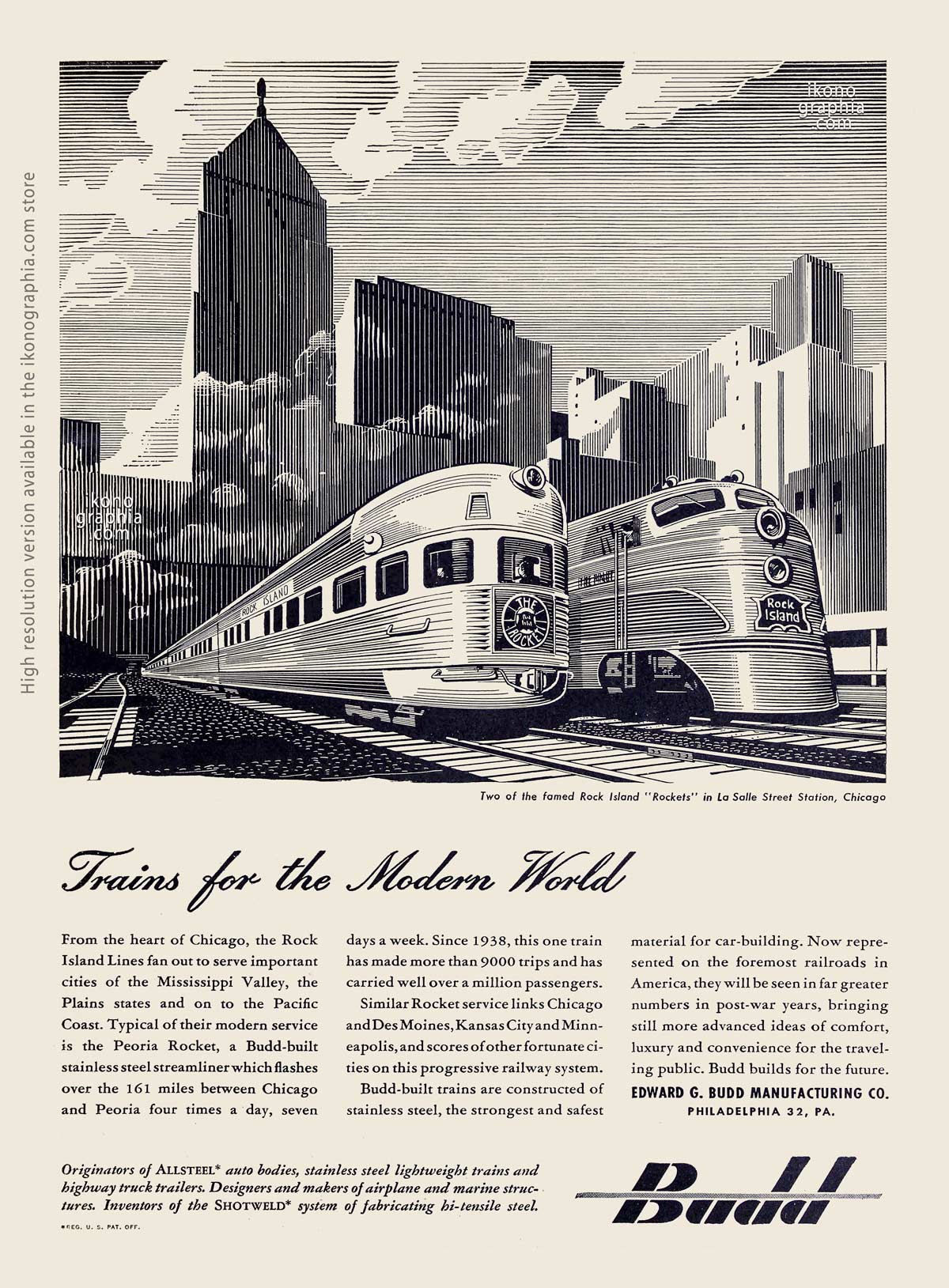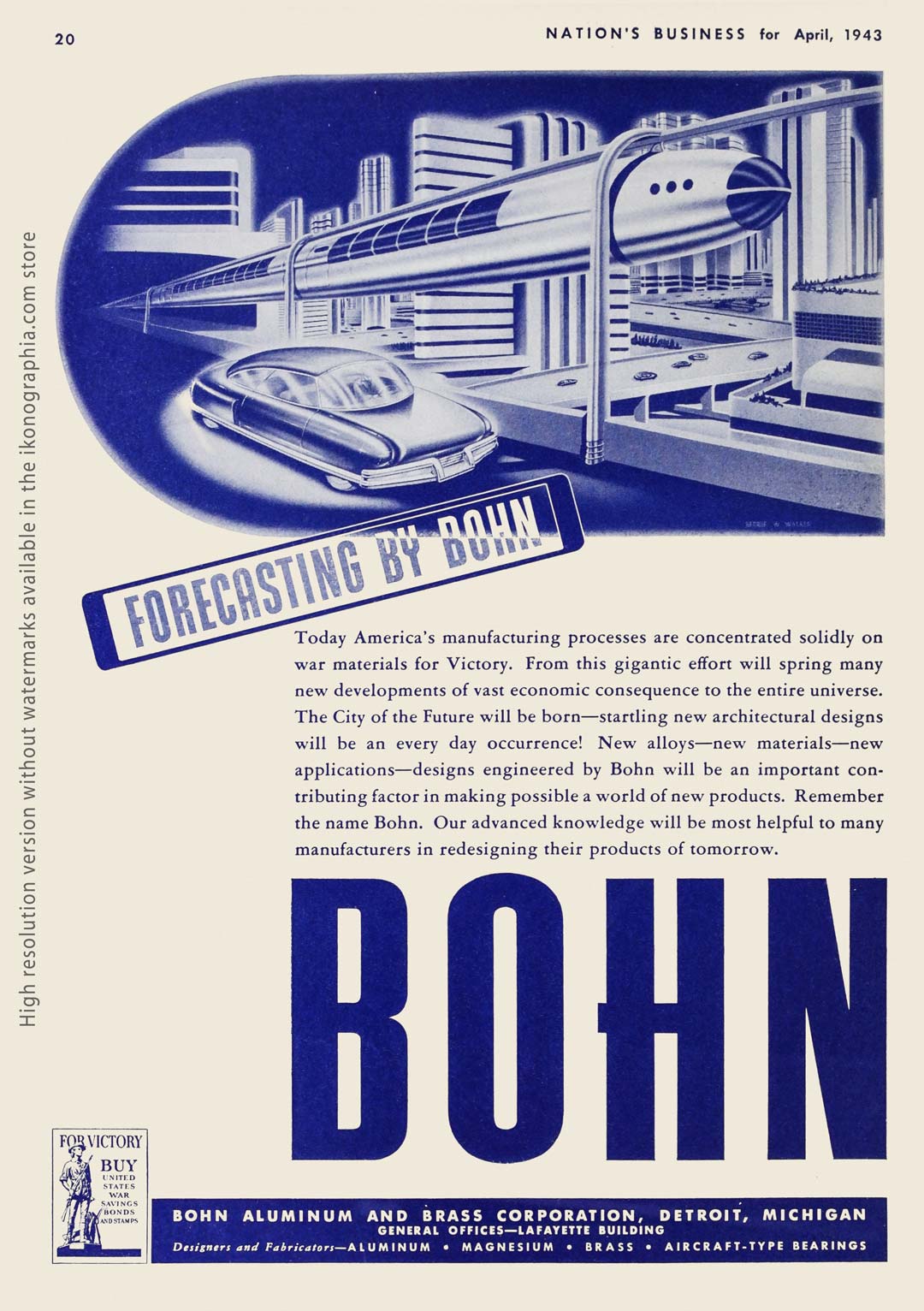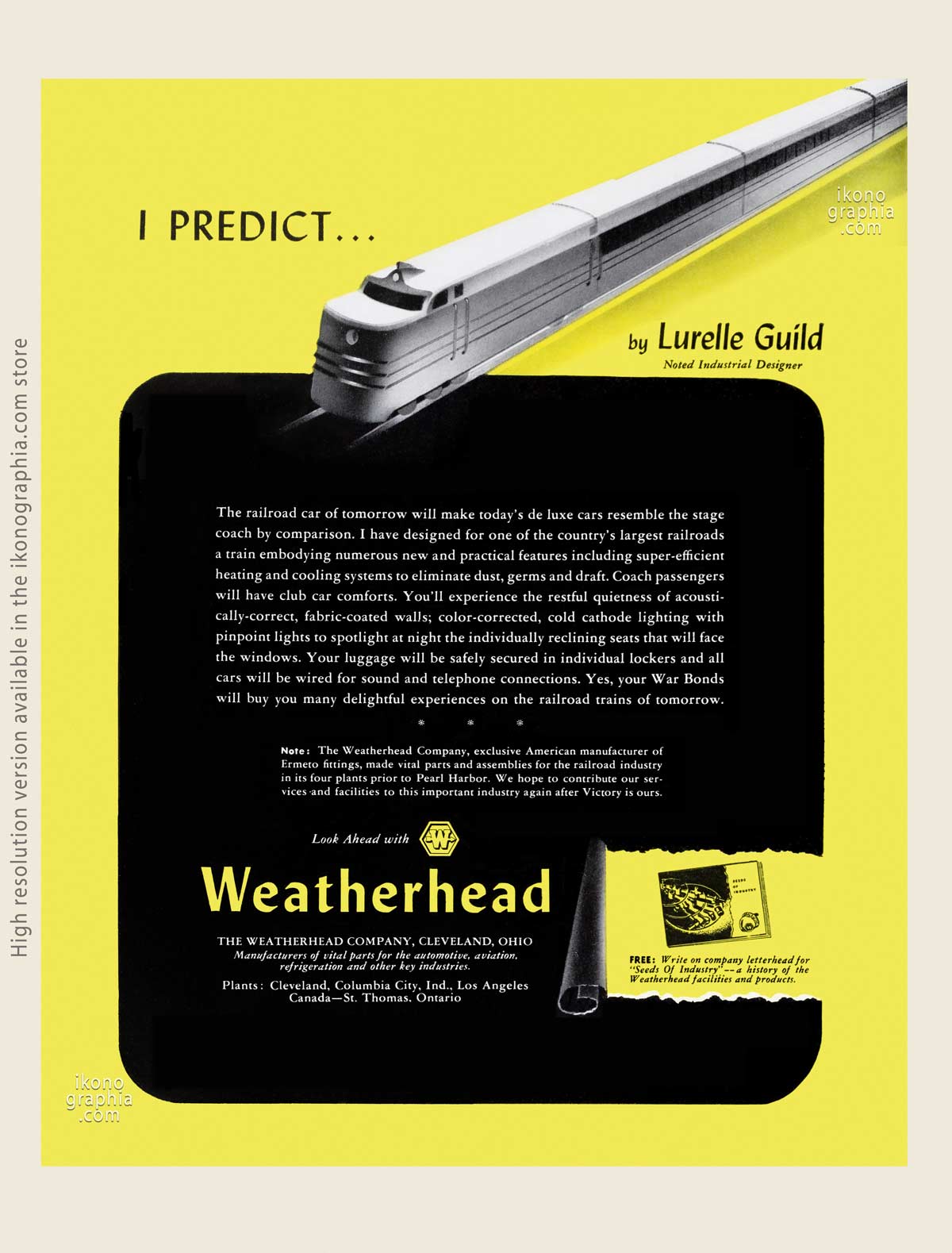American Streamlined Trains. Striking Ads of the 1940s

A “long streamlined giant capable of speed up to 120 miles an hour.” Pennsylvania Railroad Ad on Life of January 22, 1945.
Celebrating American Technological Progress.
Starting from the mid-thirties, many railroads were driven progressively out of business due to competition from buses, airlines, and Interstate highways.
The answer was the development of deluxe passenger trains, the streamliners. Some became legendary and profoundly influenced popular culture by focusing on concepts such as power, speed, technological progress, comfort, and luxury service.
Railroads’ advertisements, pamphlets, and even menus were extremely impacting, and it was not easy to select the best. We have divided this post into three parts. The second one will be “Dining on the train” and the third one on trains and WWII.
American Locomotive.
Two Trains of Thought
Life Magazine. February 16, 1942.
Are you the one person in a hundred who can point out which locomotive in this picture is the Diesel-Liner, which is the Steam-Liner? Good.*
But are you the one person in a thousand who knows which form of power the railroads need to meet the staggering transportation demands of wartime? The fact is the railroads need both. To meet certain conditions, a Diesel-liner is better. Under other circumstances, a Steam-Liner is the right answer.
That’s why we build both. Whichever we build, Diesel-Liner or Steam-Liner, it will do the job it was designed to do. And it will be one of the world’s finest, most modern locomotives.
*The lower train is pulled by a Diesel-Liner, the Upper by a Steam-Liner.
The Streamlined Trains
A streamliner is a vehicle incorporating streamlining in a shape providing reduced air resistance. The term is applied to high-speed railway trainsets of the 1930s to 1950s. Let this Pullman-Standard ad tell you all the story of its birth.
In 1933, after a painstaking investigation of all car manufacturers’ design, the Union Pacific Railroad commissioned Pullman-Standard to build America’s first modern, streamlined train. It is significant that, in the following ten years, Pullman Standard—creator of that extraordinary innovation—built more than 71% of all lightweight cars purchased.
On February 12, 1934, the M-10,000, the first modern American streamliner, was delivered by his builder, Pullman Standard, to the Union Pacific Railroad.
By December 1941, after seven years of service and 899,113 miles of fast, comfortable operation during which it had earned over three times its original costs, the City of Salina (formerly the M-10,000) was no longer able to handle the heavy traffic demands without adding cars which was impracticable with this type of articulated train. However, it had pioneered lightweight equipment—proved its practicality and economy.
With the shortage of aluminum, the Union Pacific, nine days after Perl Harbor, offered the train on the altar of freedom to be transmuted into swift fighting planes—being reincarnation for a grand and honored pioneer.
Power and Speed
The text of the Pennsylvania Railroad ad below perfectly summarizes what we said. It was published on Life on January 22, 1945.
Capable of speed up to 120 miles an hour, this long streamlined giant not only marks another forward stride in the science of railroading — it is indicative of the spirit of progress in an industry vital to the welfare of America. now and in the future.
Pennsylvania Railroad.
POWER TO PACE THE FUTURE
Life Magazine. January 22, 1945.
Here’s the drama that comes of a drawing board . . . first of a series of new engines now in service in the East-West route of the Pennsylvania Railroad!
Capable of speed up to 120 miles an hour, this long streamlined giant not only marks another forward stride in the science of railroading — it is indicative of the spirit of progress in an industry vital to the welfare of America. now and in the future.
American Locomotive.
What do you feed an Iron Horse?
Life Magazine. February 21, 1944.
Artwork with the unmistakable surreal style of Edward Hopper.
Read the ad’s full text in the tab below
Read the ad's text
It was easy to tell in the old days when you could see the boiler and the smokestack and the steam whistle. You could tell at a glance you fed it coal and water.
But these modern streamliners steeds—their stomach hidden under sleek inside bodies of gleaming steel—what is it you feed them? Coal? Oil? Or electricity?
Actually, all three are used. For modern functional railroading demands that a locomotive be powered for a specific job.
For some jobs, steam can’t be beat. For others, Diesel is the answer. For still others, it’s electricity.
That’s why American Locomotives builds all there. We know from over a hundred years of experience that only a complete analysis of the conditions to be met can return in the right selection.
Today, a large percentage of America’s crack passenger and freight trains are pulled by American locomotive engines—some Steam, some Diesel, some Electric. Each is unsurpassed at its particular job, for each was built for that particular job.
American Locomotive.
Which one is the freight locomotive?
Life Magazine. June 25, 1945.
Artwork by Peter Helck.
Read the ad’s full text in the tab below.
Read the ad's text
Which one is the freight locomotive?
BOTH ARE! And you may be surprised to learn that both are passenger locomotive, too. They are actually interchangeable.
This is important to the railroads because, until recently, freight and passenger locomotives were built differently-one primarily for hauling power, the other mainly for speed.
Today, however, out of American Locomotive’s hundred years’ experience have come locomotives that are truly multipurpose. Like the “Niagara” locomotives shown above, latest result of co-operation between The New York central and American Locomotive designers, these locomotives can haul fast freights one day and crack passenger trains the next. Moreover, they may be steam or diesel-electric or any modification of either type. It doesn’t matter whether they are powered by coal or oil-the important thing is economy of performance.
This development helps reduce the number of locomotives a railroad must buy and maintain in order to do its job. And that’s important to you. For it is out of savings that a railroad gets the money to make improvements in service.
This is just one of many developments that will contribute to finer postwar railroad service. And it is significant that it comes from the Company that built the world’s largest steam locomotive, gave America its first diesel-electric locomotive, and has supplied an important share of the locomotives now being used for war purposes by the United Nations.
American Locomotive
THE MARK OF MODERN LOCOMOTION
American Locomotive.
Quick – what’s it pulling, boxcars or berths?
Life Magazine. April 16, 1945.
Artwork by Peter Helck.
Read the ad’s full text in the tab below.
Read the ad's text
Quick – what’s it pulling, boxcars or berths?
Even a railroad man couldn’t tell–until he sees more than the locomotive.
For this particular locomotive–built by American Locomotive and General Electric for the New Haven–is the product of an important development.
You see, for years, the railroads have had to bear the terrific expense of buying and maintaining different types of locomotive for freight and passenger service. But today–as a result of American Locomotive’s hundred years of experience in railroading–this problem has been licked.
Locomotives are now being built that are interchangeable–that can haul fast freight trains one day and crack passenger trains the next. And the maybe Diesel-Electric or steam or any modification of either type. It doesn’t matter whether they use oil or coal–the important thing is economy of performance.
This development means big savings for the railroads because it helps to reduce the number of locomotives a railroad must buy and maintain. And that’s important to you. For it is out of a railroad’s savings that improvements in service can be offered.
This is just one of many developments that will contribute to finer postwar railroad service. And, significantly, it comes from the Company that built the world’s largest steam locomotive, gave America its first diesel-electric locomotive, and has supplied an important share of the locomotives now being used for war purposes by the United Nations.
American Locomotive
THE MARK OF MODERN LOCOMOTION
Read the ad's text
Something New ON THE TABLE!
For the first time, a way has been found to put into a locomotive the same kind of power that sends big battleships forward–turbine drive!
Developed by Pennsylvania Railroad research in conjunction with engineering staffs Westinghouse Electric Corporation and the Baldwin Locomotive Works, this new kind of locomotive power adds extra smoothness in fast runs–and many other notable advantages.
No bigger than your electric refrigerator, the steam turbine itself can produce power to pull the heaviest loads at high speeds. And the engineman controls the whole operation with a single small lever which works like a gear-shift on an automobile!
One of the most important changes in the power principle of the steam locomotive in over 100 years, the turbine drive engine gives promos of a great future in the field of train transportation.
PENNSYLVANIA RAILROAD
Serving the Nation
BUY UNITED STATES VICTORY BONDS AND STAMPS
Read the ad's text
ONE HUNDRED YEARS 1846-1946
THIS YEAR–1946–marks a century of progress by the Pennsylvania Railroad in service to the American people. Reflecting the tremendous industrial growth of the Country itself, this service has steadily advanced from a few trains a day to 1,340 passenger trains and 3,170 freight trains daily, operating over 10,114 miles of line extending from the Atlantic to the Mississippi. Now, as we prepare to move into a second century, our combined research, engineering, and shop facilities are producing new trains, new locomotives, new cars, new comforts, and new technical achievements . . . to add still another chapter of transportation progress that has continued for one hundred years,
PENNSYLVANIA RAILROAD
Serving the Nation
Captions:
The “John Bull,” built in 1931–America’s oldest original locomotive
A Pennsylvania Railroad Locomotive of 1865
Power in 1902 for Pennsylvania Special, forerunner of Broadway Limited
Comfort and Service
We introduce this chapter using the text of this ad American Railroads which is an extraordinary blast into the spirit of the era.
It’s a day coach. Looks pretty nice, doesn’t it? And it’s nice! Light, bright, roomy, and comfortably air-conditioned. Smooth riding at high speeds with pillow-soft seats that fairly invite you to sink down and relax — wide windows that provide a sweeping view of the scenic landscape — and dozens of important little travel conveniences.
• Where will you find such coaches as this? Many of them were built before the war began and are now in use. Hundreds more had been planned but never built — you know the reason why. • We haven’t been able to use scarce materials and manpower to build trains as we’d like to have them. There’s a war to win and doing our level best to meet the nation’s wartime transportation needs. • But we offer this little glimpse of the future because we want you to know, when you ride on our trains today, that railroads are looking ahead, planning better trains for tomorrow.
American Railroads.
Like to ride on a train like this?
Life. May 22, 1944
Artwork by John Vickery, an Australian illustrator who moved to New York in 1935.
Leisure and vacation
Excerpt from a Pennsylvania Railroad ad published on Life on June 13, 1949.
Choose your own vacationland. . . bur for extra pleasure . . . go by train!
It’s much more enjoyable. And the train is so comfortable, convenient and dependable. There’s room to roam, room to relax . . . weather you go, coach or Pullman. Your carefree vacation starts the moment you step aboard any of the 1100 daily trains that make up Pennsylvania Railroad’s great passenger fleets. No matter where you’re bound, there’s a train ready to take out on the day you play to go.
New York Central.
Holidate for two! on New York Central’s New Luxury Coaches.
Life Magazine. May 31, 1948.
Read the ad's text
Holidate for Two! on Mew York Central’s New Luxury Coaches We Couldn’t Budge on Our Budget! It looked a stay-home vacation for us . . . until we started figuring on New York Central’s low coach fares and round-trip savings. But Now Our Vacation Outlook’s Great . . . Water Level Route scenery’s a swell background for dining car meals. It makes great sightseeing, too, from the wide windows of our air-cooled coach. We’ll Have More to Spend at the Other End! Coach fares save us enough for extra vacation fun of our trip aboard world’s largest new luxury coach fleet. FREE-1948 Vacation Guide Are you summer-dreaming of the Adirondacks, Niagara Falls, New England, Canada, the Great Lakes or the Western Wonderlands? Then you’ll want this Vacation Guide, with its many pictures and fascinating fun map. For FREE copy, mail coupon to New York Central, Room 1334-L, 466 Lexington Avenue, New York 17, New York. New York Central System NEW YORK CENTRAL The Scenic Water Level Route
Pullman Standard.
“North Western” enlarges its great “400” fleet. Built by Pullman Standard.
Life Magazine. February 11, 1946.
Read the ad's text
“North Western” ENLARGES ITS GREAT “400” FLEET BUILT BY PULLMAN-STANDARD Fast, luxurious, dependable, the “400”s have won distinction among the great trains of America. You, the millions who have patronized the “400”s, have given them a service record which have few equals–bot in passengers volume and operating result.
Now come the first postwar additions to this busy popular fleet–new Pullman-Standard built the first lightweight, streamlined cars for any railroad. The North Western, likewise , has a long record of successful operation of this new equipment. Since 1933, we have built 141 lightweight cars for this railroad, or for its joint operation with Union Pacific and Southern Pacific. Watch for Pullman-Standard’s “Trains of Today!” For the safest and finest in modern rail transportation travel on trains which feature Pullman-Standard-built cars,
Pullman-Standard CAR MANUFACTURING COMPANY CHICAGO • ILLINOIS offices in seven cities . . .
Manufacturing plants in six cities World’s largest builders of modern streamlined railroad cars Caption:
The “400” Fleet operates between Chicago and Milwaukee, Wisconsin, southern Minnesota and the Upper Peninsula of Michigan.
Pennsylvania Railroad.
It’s always fair weather…when you ride this great All-WEATHER FLEET!
Life Magazine. June 30, 1941.
Read the ad's text
Pennsylvania Railroad. It’s always fair weather Life Magazine June 30, 1941
It’s always fair weather – when you ride this great ALL-WEATHER FLEET! “It’s always fair weather”. . . . because Pennsylvania’s Railroad’s great Fleet goes 365 days a year – come rain, come hail, come storm, come sun. In fact, weather has nothing to do with its smooth, punctual service.
It always goes–it always gets you there! In comfort, in safety–economically! That is why business men, travelers with appointments to keep and people to meet, vacationists eager to go–chose the fine modern trains of this vast fleet. Do as they do!
Enjoy train travel at its best! Relax in air-conditioned Lounges gayly reminiscent of the smartest clubs…enjoy foods that have home-cooked flavor…retire to the privacy of Roomettes, Duplex Rooms, Bedrooms, Compartments, Drawing Rooms, Master Rooms–and sleep in real beds! Improved Section Sleepers, too. Best of all, whether you go Pullman or in restful reclining-seat Coach, FARES ARE LOW. Why, then, consider any other travel “way”?
Box: Now Two DE LUXE ALL-COACH TRAINS New-York-Chicago The TRAILBLAZER New York-St.Louis The JEFFERSONIAN ENJOY fast service, Observation-Buffet-Lounge Cars … Radios … mart Diners serving complete dinner for 75c, luncheon 65c, breakfast 50c … Reserved individual reclining seats … Attendants. Completely air-conditioned. Low coach fares. Also through service, Washington-Chicago and Washington-St. Louis, Captions: Fair inside too! No matter how hot is outside, you enjoy the coolness of air-conditioning inside. An innovation in privacy! Duplex Rooms. Completely self-contained private rooms on two different floor levels. Individual toilet facilities–many features! THE SHORTEST ROUTE BETWEEN EAST AND WEST. Serves America’s largest cities as shown on map. Through car service to principal points in New England and the South. Convenient connections to all the West. See America for $90 in coaches. Grand Circle Tour. Coast to coast. In Pullmans –$135 plus berth charge. NEW YORK – CHICAGO . . . 18 trains daily Led by Broadway Limited, The General NEW YORK – ST. LOUIS . . . 8 trains daily WASHINGTON – ST. LOUIS . . . 8 trains daily Led by “Spirit of St. Louis” WASHINGTON – CHICAGO . . . 11 trains daily Led by Liberty Limited WASHINGTON – CHICAGO . . . 11 trains daily Led by The Congressional NEW YORK – WASHINGTON . . . 40 trains daily Led by The Congressional Plus a fleet daily serving Philadelphia, Baltimore, Pittsburgh, Columbus, Cincinnati, Akron, Cleveland, Detroit, Louisville and other important cities. GO NOW–PAY LATER. Ask about Travel-Credit Plan.
American Locomotive.
PICTURE YOUR FAMILY IN A TRAIN LIKE THIS!
Life Magazine. December 2, 1946.
Artwork by John Clymer
CHILDREN’S HOUR—ON WHEELS
One day soon you’ll board a brand -new train with the kids—and every hour of the trip will be “The Children’s Hour.”
Skilled attendants will entertain your youngsters in a wonder room made especially for children. There’ll be a building blocks, story books, slippery slides, movies, and games galore to keep their trip—and yours—from being tiresome.
This is not a blue-sky promise. Children’s playrooms are just one of the new features of crack postwar trains which are now going into production. There will also be club cars that convert into theaters or night clubs, telephone service en route, coaches with lounge-cars luxuries, and sleeping quarters with the comforts of a good hotel.
These improvements are all part of a modernization program estimated at $1,600,000,000—the greatest in the history of the American railroads. They’re coming—not in the vague future—but as soon as the modern postwar trains make their first runs.
LOCOMOTIVES AS REVOLUTIONARY AS THE TRAINS THEY PULL
Many of America’s trains will sweep down the tracks behind American Locomotive’s Diesel-Electric takes advantage of important wartime research. The turbo-supercharged engines, mass-produced on a moving assembly line, pack more power in less weight than any other railway diesel.
These super locomotives are years ahead in speed, power, smoothness and economy operation. The line includes passenger and freight diesels, road and yard switchers—an Also diesel for every railroad hauling job.
Builder of more locomotives than any other company in the world. Also has introduced many basic improvements in locomotives. Among many “first,” American Locomotive built the first Diesel-Electric back in 1925.
When you board the new wonder trains powered by American Locomotive, you’ll be riding behind the finest locomotives ever built.
Trains for Tomorrow
We introduce this chapter using the text taken from the Bohn ad shown below.
Today America’s manufacturing processes are concentrated solidly on war materials for Victory. From this gigantic effort will spring many new developments of vast economic consequence to the entire universe. The City of the Future will be born—startling new architectural designs will be an everyday occurrence! New alloys—new materials—new applications—designs engineered by Bohn will be an important contributing factor in making possible a world of new products.
General Motors.
It’s years ahead of schedule. General Motor’s Exciting New Train of Tomorrow.
Life Magazine June 16, 1947
Starting from this month, this Diesel-powered train of the future will bring to many leading American cities a preview of some luxurious comforts in store for railroad travelers.
This new and wonderful train is unlike any that ever rolled into your local station. As yet, it isn’t on the schedule of any railroad. But in it you’ll see equipment and appointments which we hope will provide new enjoyment, comfort, and utility in future railway travel.
Stroll through the Train of Tomorrow and see the many new and better things for the first time assembled in one complete train.
Conceived by General Motors engineers and stylists, this new train, from the powerful Diesel locomotive to its unique and beautiful observation car, is packed throughout with vivid and stimulating ideas for future travel pleasure. Among these, there is the Astra Dome, a 32-foot glass-enclosed observation deck built into the roof of every car—giving passengers a giraffe’s-eye view of the passing landscape and skyscape.
You’ll see a roof garden diner – a sleeping car rich in space, good taste, and comfort. You’ll see a super-restful, roomy chair — a luxuriously appointed observation lounge.
Edward G.Budd Manifacturing.
Trains for the Modern World
Nation’s Business. September 1944.
Two of the famed Rock Island “Rockets” in Las Salle Street Station,Chicago.
Read the ad's text
Two of the famed Rock Island “Rockets” in Lo Salle Street Station, Chicago
Trains for the Modern World
From the heart of Chicago, the Rock Island Lines fan out to serve important cities of the Mississippi Valley, the Plains states and on to the Pacific Coast. Typical of their modern service is the Peoria Rocket, a Budd-built stainless steel streamliner which flashes over the 161 miles between Chicago and Peoria four times a day, seven days a week. Since 1938, this one train has made more than 9000 trips and has carried well over a million passengers. Similar Rocket service links Chicago and Des Moines, Kansas City and Minneapolis, and scores of other fortunate cities on this progressive railway system.
Budd-built trains are constructed of stainless steel, the strongest and safest material for car-building. Now represented on the foremost railroads in America, they will be seen in far greater numbers in post-war years, bringing still more advanced ideas of comfort, luxury and convenience for the traveling public. Budd builds for the future.
EDWARD G. BUDD MANUFACTURING CO. PHILADELPHIA 32, PA.
Originators of ALLSTEEL* auto bodies, stainless steel lightweight trains and highway truck trailers. Designers and makers of airplane and marine structures. Inventors of the SHOTWELD* system of fabricating hi-tensile steel.
BUDD
American Railroads.
Train of Thought for the Future
Life Magazine. March 27, 1944.
Artwork by James Bingham
Read the ad's text
TRAIN OF THOUGHT FOR THE FUTURE
Some day this war will be won by America and her Allies.
Our first duty meanwhile is to meet the demands of the war. This we are doing.
The going hasn’t always been easy or comfortable. We believe you understand the reasons, and we appreciate your patience, your good-humored acceptance of inconvenience.
And we’d like you to know our ideas of comfort and style go far beyond what we’re able to offer today. That’s why we print the picture below.
It will give you some idea of how we’d like to serve you — how we’re looking and planning ahead right now to make future railroad travel a thrillingly pleasant experience.
It can’t be done all at once. It will take money and time.
But you can be sure of one thing. Our goal is to give future America the finest transportation the world has ever seen.
ASSOCIATION OF AMERICAN RAILROADS
ALL UNITED FOR VICTORY
Forecasting the Future
We introduce this chapter using the text taken from the Bohn ad shown below.
Today America’s manufacturing processes are concentrated solidly on war materials for Victory. From this gigantic effort will spring many new developments of vast economic consequence to the entire universe. The City of the Future will be born—startling new architectural designs will be an everyday occurrence! New alloys—new materials—new applications—designs engineered by Bohn will be an important contributing factor in making possible a world of new products.
Bohn Aluminum and Brass
A DREAM TRAIN COMES TRUE
Fortune. January 1943
Artwork by George W. Walker, an American industrial and automotive designer based in Detroit. His most notable work was the original Ford Thunderbird.
Read the ad's text
A DREAM TRAIN COMES TRUE
The Train of Tomorrow, pictured above, is not merely a dream. Out of America’s tremendous war effort will come amazing new products—new advantages—new economies.
Bohn as the only large-scale organization in the world specialized in advanced engineering of aluminum, magnesium, and brass applications can therefore give unbiased advice on the use and fabrication of each of these vital metals. remember the name, Bohn.
Right now of course, this entire organization is working on war production. Later on, when the right time comes, you may be able to use the vast Bohn resources most advantageously and profitably.
Read the ad's text
ALL THE Comforts OF ROAM!
The day is coming when a train trip will again be something to look forward to eagerly — something to be enjoyed at ease, in spacious comfort — and all at moderate price.
That of course will be after the war is won. It will be when the armed forces no longer need nearly half of all our passenger equipment to move fighting men. It will be when many coaches and Pullmans now busy in war service can be honorably retired to make way for new cars with comfort, convenience and thoughtful appointments beyond anything the past has known.
That will take money — vast sums of money . It will take time. But we believe that it is worth while today to tell you what we plan for tomorrow — to help you realize that the wartime service we are able to give today is by no means a sample of what’s in store for the future.
ASSOCIATION OF AMERICAN RAILROADS
ALL UNITED FOR VICTORY
Bohn Aluminum and Brass
Forecasting by Bohn
Nation’s Business. April 1943
Artwork by George W. Walker, an American industrial and automotive designer based in Detroit. His most notable work was the original Ford Thunderbird.
Read the ad's text
NATION’S BUSINESS for April, 1943
FORECASTING BY BOHN
Today America’s manufacturing processes are concentrated solidly on war materials for Victory. From this gigantic effort will spring many new developments of vast economic consequence to the entire universe. The City of the Future will be born—startling new architectural designs will be an every day occurrence! New alloys—new materials—new applications—designs engineered by Bohn will be an important contributing factor in making possible a world of new products. Remember the name Bohn. Our advanced knowledge will be most helpful to many manufacturers in redesigning their products of tomorrow.
BOHN
BOHN ALUMINUM AND BRASS CORPORATION, DETROIT, MICHIGAN
GENERAL OFFICES—LAFAYETTE BUILDING
Designers and Fabricators—ALUMINUM • MAGNESIUM • BRASS • AIRCRAFT-TYPE BEARINGS
A prediction by Lurelle Guild
Lurelle Van Arsdale Guild was an architect, industrial and interior designer, illustrator and writer. In this 1944 ad for the Weatherhead Company, he predicts the future of railroad cars.
The railroad car of tomorrow will make today’s deluxe cars resemble the stagecoach by comparison. I have designed for one of the country’s largest railroads a train embodying numerous new and practical features, including super-efficient heating and cooling to eliminate dust, germs, and draft.
Coach passengers will have club car comforts. You’ll experience the restful quietness of acoustically-correct, fabric coated walls; color-corrected, cold cathode lighting with pinpoint lights to spotlight at nightie individually reclining sets that will face the windows. Your luggage will be safely secured in individual lockers, and all cars will be wired for sound and telephone connections.
Yes, your War Bonds will buy you many delightful experiences on the railroad trains of tomorrow.
The Weatherhead Company
I Predict…by Lurelle Guild
Fortune. February 1944
Artwork by Lurelle Van Arsdale Guild, an architect, industrial and interior designer.
Links, copyrights and credits
In the United States, anything, published without a copyright notice between 1923 and 1977 is in the public domain and is free to use.
Works published with copyright advice in the United States until 1963 fell into the Public Domain if the copyright was not renewed with the Copyright Office during the 28th year after publication. Ads copyright virtually was never renewed and fell in the Public Domain.
It is unlikely, but not impossible that these ads’ content is not in the Public Domain in other countries.
More info on our “Copyright and Public Domain” page.
Please notice that any advice or comment provided here is not and does not purport to be legal advice as defined by s.12 of Legal Services Act 2007.

